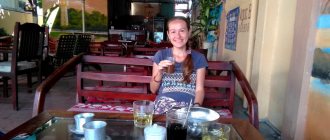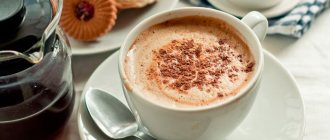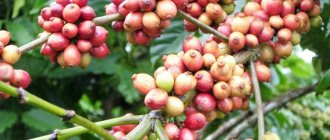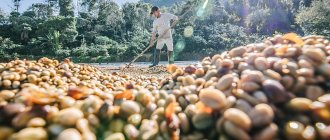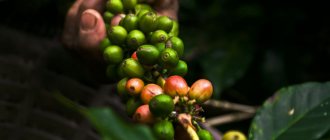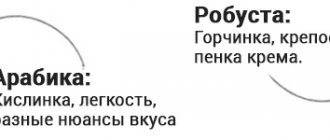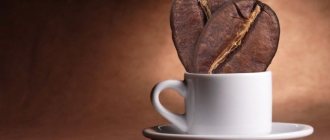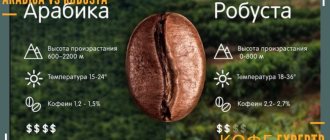Coffee is the ideal start to the morning for every connoisseur of this aromatic drink. It’s not for nothing that there is an opinion: if you don’t drink a mug of coffee in the morning, the day is wasted. This drink has an invigorating effect due to the caffeine content, increases productivity and makes the brain work.
Some people prefer instant coffee (coffee drink), others prefer brewed coffee. With milk, lemon, cream, ice cream, sugar, fruit syrup - there are a huge number of options for preparing this drink.
There are quite a few types of coffee. And it is the variety, the collection process, how the collected beans are processed, and how the coffee brewing process itself occurs that determines its taste in each cup. So, how much do the most high-end, expensive coffee beans cost and how common are they?
Black Ivory
Translated it means “Black Tusk” and the price of this coffee beans is very high. Apart from Thailand, Black Ivory is not produced anywhere in the world. These are not just roasted coffee beans. In order to get a kilogram of this coffee, it is necessary to collect about 33 kg of selected Arabica beans and they must be eaten by an elephant, along with rice, cane sugar and fruit.
For a kilogram of Black Ivory beans you will have to pay more than $1000.
Digestion of this mixture lasts up to 35 hours. During this time, the grains become saturated with fruity aroma. As the berries pass through the elephant's gastrointestinal tract, they break down protein, which would otherwise give the drink a bitter taste if the grains were processed normally. The taste of Black Tusk is soft, without bitterness, with a slight hint of fruity aroma.
To get grains ready for brewing, you need to select berries from the manure, wash them thoroughly and dry them. It is possible to drink a mug of this coffee only in the Maldives, Abu Dhabi, and also in the reserve, which is located on the borders of Thailand and Laos.
Where to buy decaffeinated coffee (fresh + store brands)
Once again, we are not talking about soluble. And in general, if you drink decaf, then it’s freshly roasted. Moreover, this is the case when many owners of home automatic coffee machines make sense to take a closer look at the ground coffee, unless, of course, you have a separate coffee grinder. Not because the ground does not lose to the grain, of course it does. But because there are usually far fewer drinkers with contraindications or those who like to drink it at night in a group or family than there are ordinary coffee drinkers, and almost all coffee machines have only one grain hopper.
You will not be able to add decaf at any time; you will have to either clean the coffee grinder or use the ground coffee shaft. An exception is machines with two hoppers and/or two coffee grinders (Delonghi Maestosa, Siemens EQ9, Melitta Barista). And, well, this one is Melitta Varianza CSP, it has one coffee grinder, but there is another function that allows you not to mix beans (more details in its review).
Actually, where to buy freshly roasted decaf?
From numerous coffee producers (roasters). Here are a few that I know:
- NEVA - Lat. America – direct (ethyl acetate) – 1550 RUR/kg ← -10% using my promotional code 101KOFE
- Bravos – Mexico – direct (dichloromethane) – 2324 RUR/kg ← -20% using my promotional code 101KOFE
- Tasty Coffee – Colombia – straight (ethyl acetate) – 1779 RUR/kg ← -10% using my promo code 101KOFE
- Torrefacto – Guatemala – direct (dichloromethane) – 2164 r/kg
- Torrefacto – Water Decaf – water – 2164 r/kg
- Sunrise Coffee – Guatemala – straight (dichloromethane) – 2304 RUR/kg
- Evadia – Center. America – direct (ethyl acetate) – 1500 RUR/kg
- Tabera – Guatemala – direct (dichloromethane) – 2300 RUR/kg
- Majaro – Colombia – direct (ethyl acetate) – 1819 r/kg
- Madeo – Colombia – direct (ethyl acetate) – 2600 RUR/kg
- TAB – Guatemala – direct (ethyl acetate) – 1776 r/kg
- KOF – Ethiopia (!) – water – 2399 RUR/kg
- Esperanto – Brazil – direct (ethyl acetate) – 1800 RUR/kg
As you can see, freshly roasted beans are available that are decaffeinated by the first, traditional method, and by the third, water-based method.
Okay, a couple of examples of “store-bought” brands of decaffeinated coffee, mostly carbon dioxide in use here - the fifth method:
Lavazza Decaffeinato = carbon dioxide. See prices. Hausbrandt Decaffeinato = carbon dioxide. See prices Illy Decaf = carbon dioxide. Buy on the Market
In conclusion, a few words about capsule decaffeinated coffee
Decaffeinated coffee capsules for the Tassimo system, as far as I know, have never existed. An “official” Espresso Decaffeinato is produced for Dolce Gusto, but it is almost impossible to buy it in Russia. It is possible that some caffeine-free capsules for Dolce Gusto are made by third-party companies, but I have not come across them.
The largest selection of decaffeinated capsules is, of course, for Nespresso. There are 4 branded types: Arpeggio Decaffeinato, Volluto Decaffeinato, Vivalto Lungo Decaffeinato, Ristretto Decaffeinato. Plus a lot of alternatives, for example, from Julius Meinl or Lavazza. I don’t know about the latter, but the original Nespresso decaffeinated capsules are produced using the “water” method.
Kopi Luwak
In second place in the ranking is coffee, which is produced only in 3 countries - South India, the Philippines and Indonesia. Musangs (also known as luwak) are small animals whose food consists of ripe coffee beans.
The average cost of one cup of this coffee is $100.
Civet, a substance present in the gastric juice of musangs, helps give the final uniqueness and uniqueness to the taste of coffee. In total, about 500 kilograms of Kopi Luwak are produced annually. Only true gourmets can afford it. They say this coffee has a subtle aroma of chocolate and jungle.
Differences in the taste of decaffeinated coffee
No matter what anyone says or advertises, I have not yet come across a brand of decaf coffee that is not different, or I would even say, not inferior to regular bean coffee. They are all worse to one degree or another. They have not yet come up with either a solvent or a filter that would bind/retain/extract only caffeine from the beans and nothing else. Inevitably, other components are removed from coffee, the body of the drink becomes weaker, the taste is flatter, and the bouquet is simpler.
And the initially worse/older the grain, the more critical the changes. If the variety did not have a very pronounced taste before the decaffeination process, then after it it becomes completely bland. It is clear that manufacturers, in principle, use Arabica varieties with low caffeine content to make the process faster and cheaper. And low caffeine content often correlates with a bias towards acidity. It is clear that the cheaper the decaf in the store, the more shameful the original grain was. The process itself costs a significant amount, so good quality decaffeinated coffee must be more expensive than similar decaffeinated coffee.
As a result, after removing caffeine, the taste not only becomes poorer, but it also begins to become more sour, with wine notes, the bright shades, if they were there initially, are muted, and the bouquet becomes even. The aftertaste often reveals an astringent herbal taste or notes of unfinished baked goods. Which I personally don't like. Another thing is that if you bought a fairly expensive decaf, which is also freshly roasted (and freshly roasted coffee always has a brighter and richer taste), then these nuances can be considered a feature of the blend.
Blue Mountain
A variety of Arabica beans. Coffee trees grow on mountain plantations in Jamaica. The grains themselves are of a very unusual color - blue-green. Hence the name – “Blue Mountain”.
The cost of the beans is $200 per 450 grams.
Light astringency, slight sourness and a breathtaking aroma are what perfectly characterize Blue Mountain.
Coffee from Saint Helena
Saint Helena Island can be called pristine. It is located far from industrial facilities. Clean air and good ecology are the key to successful cultivation of coffee trees and production of an elite drink.
The price of 500 grams of such coffee beans is about $100.
The plantations are located at an altitude of 3000 meters, the soil is of volcanic origin. Coffee beans from St. Helena Island are an elite and rare variety.
The benefits and harms of decaffeinated coffee
Benefit. The benefits of regular coffee are not considered 100% proven, for that matter. But it is believed that it is approximately the same for decaffeinated coffee. Rather, benefit refers to the absence of caffeine's effects on the nervous, cardiac, and vascular systems.
I translate this into Russian as follows: decaffeinated coffee should only be drunk by those who:
- Medical contraindications to the usual.
- An acute desire to drink coffee before bed, after which problems with insomnia arise.
- Suddenly pregnancy or even breastfeeding occurred.
Whether pregnant women can have decaffeinated coffee, as well as while breastfeeding, is still a debatable issue. From what I know, Swiss Water decaf 1-2 servings before lunch is definitely possible. But I had no personal experience, sorry.
The situation with harm is the same. If there is harm from other substances contained in green coffee, then it persists when consuming decaffeinated coffee. Plus, in the case of production using a direct traditional method, one can theoretically add the influence of chemical solvents. But on the other hand, they are also used to create instant coffee, regular, with caffeine. And no one is worried about this fact.
Personally, I believe that decaffeinated coffee does not have any particular benefit or harm, if we consider its effect separately from the benefits and harms of the presence/absence of caffeine as such.
El Ingerto
The place of origin of El Injerto coffee beans is the Republic of Guatemala. This variety of coffee is much cheaper than Black Ivory, but still expensive.
Its average price is $50 per 450 gram package.
The peculiarity of this coffee is its exquisite taste and aroma. The climate of Guatemala is cloudy and it often rains, which is why El Injerto has an extraordinary taste and the highest quality of beans.
Hacienda Santa Ines
This is perhaps the best coffee produced in Brazil. Refreshing notes of citrus and a taste of chocolate prevent this coffee from being confused with other varieties.
450 grams of Fazenda Santa Ines, costs $50.
Coffee beans of this variety have become especially popular and widespread in Brazil and Canada. The main distinguishing factor is the manual collection of grains.
Los Plains
Los Plains are grown in El Salvador. It has a sweet floral aroma, and bright notes of cocoa are felt in the taste. Also, it is worth noting that the taste of this coffee is very rich and opens with each subsequent sip of the aromatic drink.
Price 450 gr. of Los Plains coffee beans is $40.
Los Plains coffee has received many international awards and its taste is highly valued by gourmets.
For more than 110 years, the best coffee shops and restaurants have been offering their guests a wonderful variety of Danesi coffee flavors. The history of the brand begins in 1905, from a tiny premises in densely populated Rome. It was there that son and father first began experimenting with mixing and roasting coffee beans. Today Danesi has more than 20 consumer countries, hundreds of thousands of customers around the world and numerous unique blends.
The principles on which the company’s policy has been based for many years are:
- Attention to quality. Indeed, Danesi specialists closely monitor the plantations during the growing period. Afterwards - its collection, packaging, storage and transportation. And strict control is exercised at every stage.
- Introduction of new technologies and recipes. The company established itself as a fearless experimenter back in the 1900s. They are not afraid to try, and this contributes to the emergence of unique drinks.
- Natural drying. Only clean and natural air can dry grains as they should. The brand does not strive to cover huge volumes of consumption, paying attention to the quality of the process rather than the quantity of the product produced.
Danesi provides its customers with consistently the best coffee. Which directly affects the brand’s reputation as one of the flagships on the market.
Wealth of options
Today Danesi offers coffee for every taste. Here you will find both 100% Arabica from the best high-mountain plantations, as well as unique mixtures of varieties to obtain an exclusive taste.
Among the wealth of options, the following stand out:
- Emerald – this is the coffee that we recommend introducing the brand to. It can be called the most universal. A blend has been created from several varieties of the best Brazilian Arabica and the highest class African Robusta. The drink is moderately strong, rich, with light hints of nuts, chocolate, and rye bread. Roast medium-dark, long. The coffee has a great aftertaste and luxurious aroma.
- Classic Danesi is the most classic blend, familiar and loved by most gourmets. Robusta 15% and Arabica 85% merged into a single flavor ensemble. Light notes of dried fruits and pleasant softness have made the drink made from these beans a favorite of coffee shops. It can be called a classic representative of Italian espresso.
- Gold – 100% Arabica from the best varieties of Brazil, Kenya, Central America. The drink has a pleasant tenderness and a slightly noticeable bitterness. An excellent option for lovers of natural Arabica coffee.
- Decaf – soft aftertaste, pleasant aroma, natural grain and long shelf life. All these benefits are now available without caffeine. Danesi have developed a special product that includes the same selected grains. However, during its creation, an innovative processing technique was used to reduce the caffeine content.
- Doppio is an exclusive blend of 100% Arabica coffee, collected on the best plantations of Ethiopia, Central America, and Brazil. Its rich taste and invigorating aroma will fill the cup with chocolate and cream notes.
This is not the entire list of excellent coffee from Danesi. Thanks to different packaging, everyone can try such an elite product. Grains are offered in bags and cans from 0.25 to 1 kg. This brand has long been at the top of the European coffee Olympus and confidently maintains its leading position. Having tried it once, everyone is convinced of its unsurpassability.
Kona coffee
Coffee trees of this variety grow on the slopes of volcanoes in Hawaii. The elite quality of Kona coffee lies in the fact that it is “born” in unique climatic conditions.
The price of Hawaiian coffee is approximately $35 per 450 grams.
Rich soil is also an important factor for growing quality coffee beans.
Blue Bourbon
This type of coffee was first produced in 1789 on Reunion Island, which is located in the Indian Ocean. The old name of the island is Bourbon. Blue Bourbon is made from Arabica beans. The taste of Bourbon is distinguished by strong sourness and a rich, bright bouquet of spices.
This is why coffee beans of this variety are highly valued on the world market. The cost of 450 grams of Blue Bourbon beans is no less than $35.
Elite coffees are very expensive. But their taste and aroma are significantly different from those varieties that everyone is used to drinking in the morning. Every true coffee connoisseur should try the most expensive varieties of this wonderful drink at least once in his life in order to fully enjoy the kingdom of coffee taste and aroma!
Decaf - what is it?
Decaf coffee, also known as decaffeinated coffee, also known as decaffeinated coffee, is coffee that has undergone a decaffeination procedure in one way or another. There are only five such methods, but in fact there are two on sale. Up to 99.9% of the original caffeine content can be removed from coffee, resulting in a reduction in a cup from an average of 100 mg to 3 mg in terms of pure substance.
How to make decaf coffee (old and modern methods)
- A method that was first invented in 1905 and is now prohibited is to extract caffeine with benzene from green beans soaked in water.
- “Direct”, aka “European”, aka “traditional” method. Green coffee is steamed for about 30 minutes or soaked briefly in hot water, then soaked for 10 hours in water with a solvent - dichloromethane (pure chemistry, by the way, is used in the production of almost all instant coffee) or ethyl acetate (ethyl acetate). The solvent binds to the caffeine, after which the solvent remains to be disposed of. This is done by evaporation, which takes about another 10 hours. When using ethyl acetate from fruits or cane sugar, the method is called "natural". But don’t fall for the marketing; in reality, when using this method, in 95% of cases an industrially synthesized chemical compound is used, although it is low-toxic. Most decaf decaf on the market is made this way.
A real barrel of dichloromethane, used for decaffeination. It looks like a nasty chemical (and it is), but the coffee itself is quite safe. A residual level of 10 ppm (parts per million) is considered acceptable; in reality, about 0.1 ppm remains in modern decaffeinated coffee. In other words, 1 kg of decaf contains no more than 0.0001 grams of dichloromethane.
- "Indirect method". The grains are soaked in hot water and removed. Caffeine is removed from water using a solvent according to the method above. But at this moment there are no grains in the water. The same grains are again immersed in the same water, but with the caffeine almost removed, and soaked again. Then the grains are taken out again, and caffeine is removed from the water again, and so on up to 10-12 times. The point is that the final soak ensures that the balance of caffeine in the beans and water is at a minimum level, and that no other substances are lost. That is why the grains are not soaked in clean water every time; in 10 sittings it would remove not only caffeine, but generally all substances from them. A more progressive, but also longer, and therefore more expensive method.
- “Swiss Water”, also known as “Swiss water”, “Swiss method” or simply “water”. This is a variation of the indirect method described above, only from water in which the same grain is soaked several times in a circle, caffeine is removed not with a solvent, but with the help of a carbon filter. The same water is used and is called “Green Coffee Extract” (GCE). The method is even more expensive, and therefore even less common, than the previous one. According to rumors, at the end of 2022, decaffeinated green coffee, which is removed using the Swiss method, will not be supplied to Russia.
Photo: www.swisswater.com
- "Mountain Water", "mountain water". A complete analogue of Swiss water, but the water used is not just any kind, but glacier water. Purely a marketing ploy. I didn't come across it.
- Using carbon dioxide (CO2) in a supercritical (liquefied) state under pressure up to 300 atm for the production of decaffeinated coffee. In this form, the gas acts as a solvent; the method is logically “direct”. It is considered the most expensive due to the complexity of the equipment used; it is used by the world's decaf.
Apparatus for decaffeination of grain from ThyssenKrupp using the “fifth” method. This is used in the factories Dallmayr, Jacobs, Melitta and Lavazza.
So, more or less realistically in Russia you can buy decaffeinated coffee produced by methods 1, 3 and 5. The first is the most controversial, cheapest and most common. The third is the safest and highest quality.
